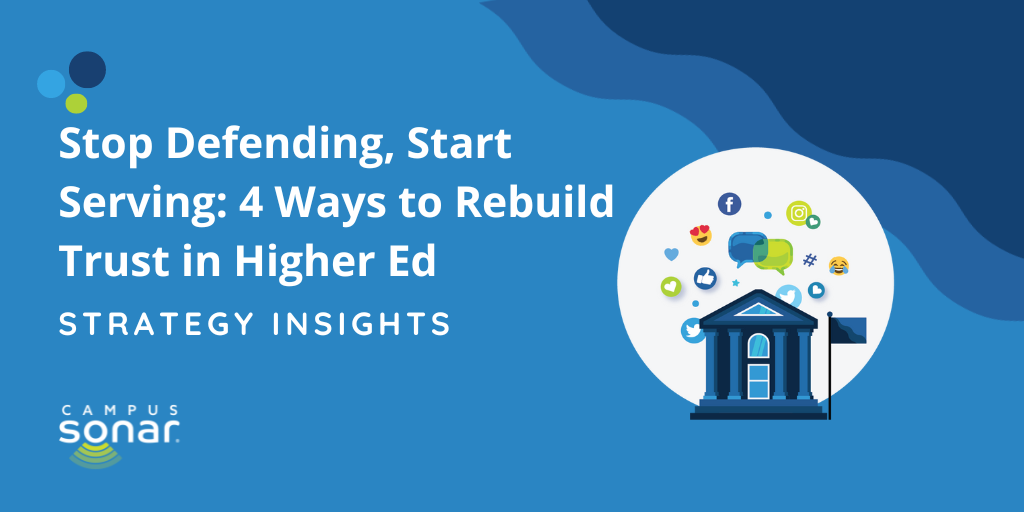Stop Defending, Start Serving: 4 Ways to Rebuild Trust in Higher Ed

We don’t need another study proclaiming that public trust in colleges and universities is at an all-time low in our country. The conclusions are predictable, and so is the response; a defense of higher education as it always has been, often putting the blame on the public who just doesn’t get why it’s so important. Defending, rather than listening to understand, is doing more harm than good.
Public trust is belief and confidence driven by positive expectations based on experience and perception. To rebuild public trust, you must understand its drivers—expectations and perception being two that are formed without stepping foot onto your campus or logging into an online classroom. In this age of online communication, they’re often formed in peer-to-peer online spaces or through the media. Social intelligence allows us to understand experience and perception, identify gaps, and design a path forward that meets expectations, results in positive experiences, and improves public perception.
That’s exactly what we did in Rebuilding Trust in Higher Education: A Social Intelligence Report. We share findings about consumer sentiment, expectations, and the cautionary caveats prospective students are encountering when they seek opinions about college value online. Rather than doom and gloom, we focus on the path forward to rebuild trust with four recommendations supported by our analysis. These recommendations happen to align with Deloitte’s Four Factors of Trust—something I discovered while developing a workshop for senior leaders with Emma Jones from Credo. The parallel provides evidence for some outcomes you can expect by following this path: increased positive word of mouth, high value perception, competitive advantage, and ability to make and recover from mistakes.
Aligning Social Intelligence and a Research Based Framework |
|
Social Intelligence-Informed Recommendation |
Deloitte Trust Factor Research |
| Lead with transparency by actively addressing pain points, weaknesses, and barriers; clearly communicating cost and value; differentiating your offerings with realism. |
Transparency: Continual sharing of information that impacts people. Consumers who believe a brand is high in transparency are 2x more likely to promote the brand on social media. |
| Frame messaging with outcomes in support of individual, community, and societal outcomes; amplify as many individual alumni stories as possible; leverage alumni brand affinity. |
Reliability: Continual delivery on promises made. Consumers who believe a brand is high in reliability are 2.1x more likely to spend more on the brand compared to a similar product or service |
| Prioritize student support services and the communication about them to combat the common caveat that students are on their own once they start their education, and demonstrate how education connects to career preparation. |
Capability: The observable skills required to deliver on a promise. Consumers who believe a brand is high in capability are 3x more likely to choose the brand over its competitors |
| Listen to and serve your audiences, especially those from marginalized communities who harbor distrust based on prior experiences. |
Humanity: Recognition of the uniqueness of each person. Consumers who believe a brand is high in humanity are 2.5x more likely to stick with a brand through a mistake. |
Implementing these recommendations will improve your brand and reputation as well as public trust. Doing so successfully will require listening and storytelling infrastructure, specialized talent, evolved strategy (all of which we support for our clients), and significant shifts in campus culture and momentum. While brand and reputation is a marketing objective, building trust is not solely a marketing initiative. This confluence brought Emma and I together to develop Building Trust as a Higher Ed Leader: Articulating Value, Navigating Change. While the live workshop has passed, you can request a recording or perhaps catch us at a future event.
Rebuilding trust is necessary for higher ed to reclaim its relevance and continue serving our communities as their needs evolved. By mission, campuses are learning organizations—the foundation for change is there. Leaders must be willing to lead boldly, think differently, and approach their decisions with an audience-first framework and a spirit of service. As a public good, higher ed can’t relinquish this work to private industry—but we risk doing so if we’re too slow or unwilling to adapt to the needs of individuals and communities who depend on us.

